
Swordfish
Getting Started with Swordfish
Only a few steps are necessary to translate with Swordfish. The basic workflow for translating documents is:
Step 1: Setup Memories and Glossaries
Swordfish uses Translation Memory (TM) technology to assist translators. It stores your translations in Memories and offers them again when you need to translate a similar text.
- Click on the Add Memory button () of the Memories tab toolbar to create a Memory for storing your translations.
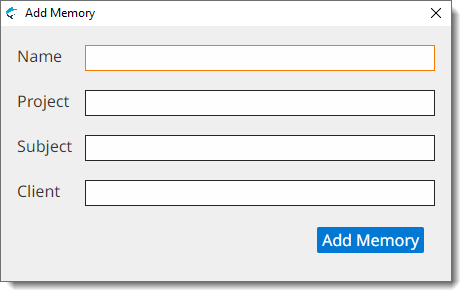
Add Memory Dialog
- If you have Translation Memory data in TMX format, import your TMX files into your memories clicking on the Import TMX File button () of the Memories tab toolbar.
Use Glossaries to store frequent terms and their translations for consulting at translation time. Your glossary entries can also assist in assembling matches with the Auto-Translation engine included in Swordfish.
- Click on the Add Glossary button () of the Glossary tab toolbar and complete the data requested in the dialog that appears.
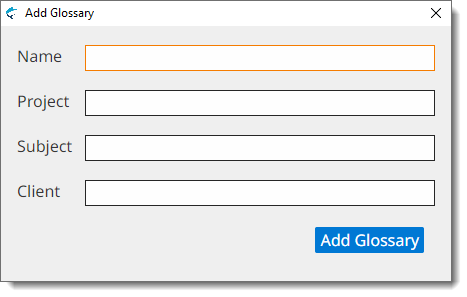
Add Glossary Dialog
- If you have terminology data in TMX or TBX format, import that data into your glossaries clicking on the Import Glossary button () of the Glossaries tab toolbar.
Note: you can reuse memories and glossaries in different translation projects. It is not required to create a new memory or glossary at the start of each project.
Step 2: Create a Project
Swordfish allows you to translate one or more files at a time. Translation tasks are organized as Projects.
There are two methods for creating projects:
- Click the Translate Single File button () in the Projects tab toolbar to create a project containing one file using a simplified dialog.
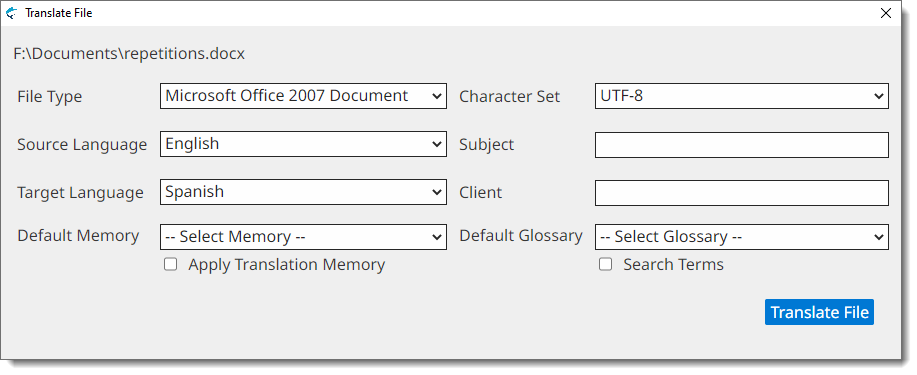
Translate Single File Dialog
- Click the Add Project buton () in the Projects tab toolbar to create a project containing one or more files.

When you create a project from a single file, the file name and location are used as project name.
Step 3: Translate a project
New projects are opened automatically for translation. To continue work on a closed project:
- In Projects tab, click the project that you want to translate.
- Click the Translate Project button () on the Projects tab toolbar.
The translation view has these special areas:
- Top Toolbar
- Contains an array of buttons for performing different tasks. It also contains drop-down selectors for the active and glossary.
- Translation Panel
- Large scrollable table of segments, showing source text, segment status and translation.
- Side Panel
- Located on the right side, this section holds three panels: Translation Memory, Machine Translation and Terms.
- Navigation & Status Bar
- Located at the bottom, this area contains buttons for navigating between project pages and provides translation status information.
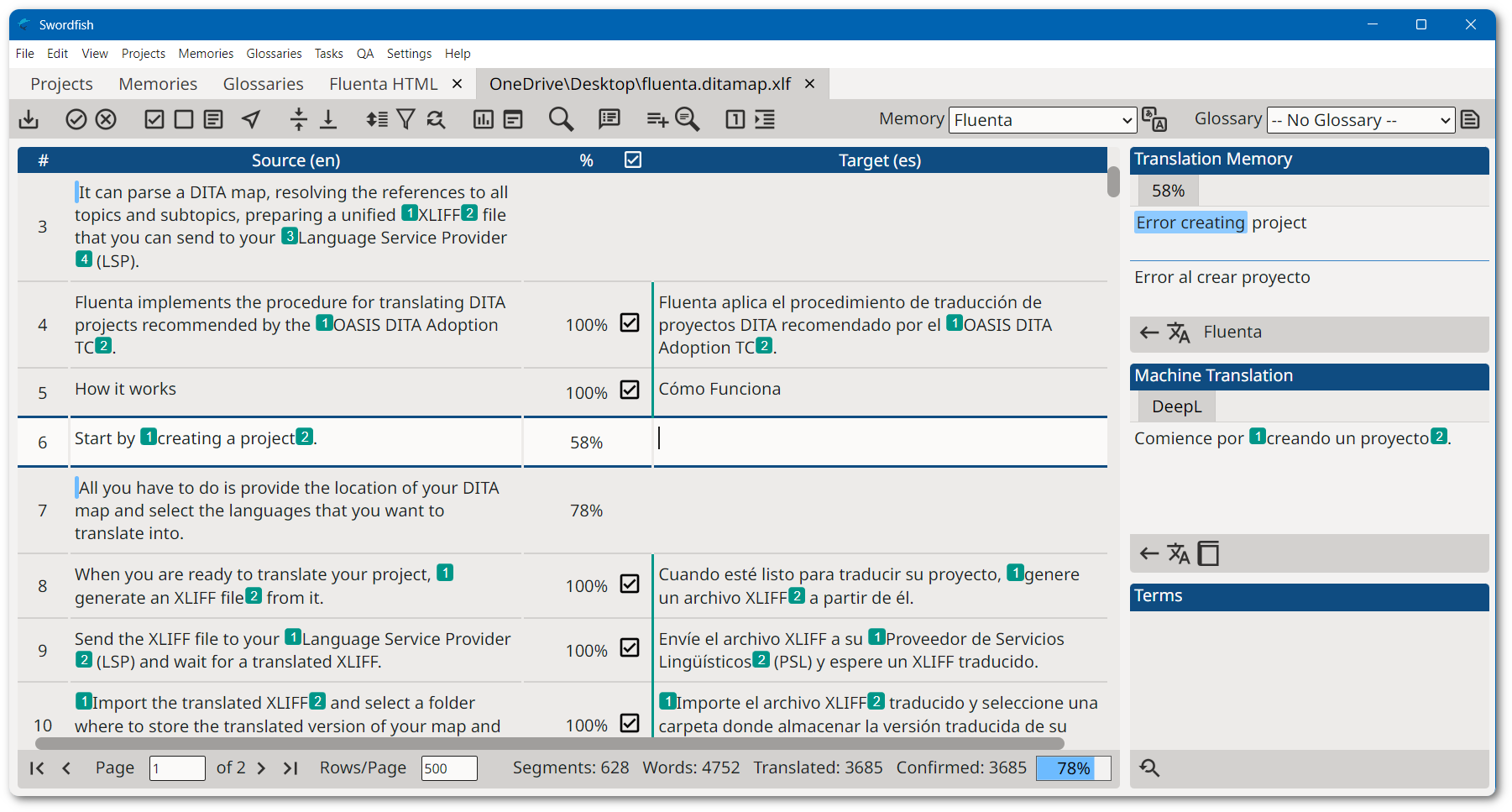
Translation View
Click on a segment to start translating it. The corresponding row is highlighted and centered on screen (whenever possible) and the cursor is positioned at the start of target text.
Source formatting is represented with green marks containing a number (i.e.: ). To insert green marks, also known as tags, press Ctrl+N on Windows/Linux, (Cmd+N on macOS) where N is the number in the mark. To insert a tag greater than 10, press Ctrl+T (Cmd+T on macOS) and use the Tags dialog. You can also use the different options for managing tags available in Edit menu.

Tags Dialog
Note: In case a segment has tag errors or initial/trailing spaces errors, a warning icon () is displayed in the center column of the Translation Panel when the segment is confirmed.
When the segment is fully translated, press Ctrl+E (Cmd+E on macOS) or click the Confirm Translation button () on the top toolbar to confirm it. When you confirm a segment, its translation is stored in the memory selected in the Memory drop-down of the top toolbar and is also automatically propagated to all similar unconfirmed segments.
You have two more options for marking a segment as confirmed:
- Press Alt+Down Arrow (Ctrl+Alt+Down Arrow on macOS) or click the Confirm and go to Next Untranslated button () on the top toolbar to confirm current segment and open next untranslated one.
- Press Alt+Shift+Down Arrow (Ctrl+Shift+Down Arrow on macOS) or click the Confirm and go to Next Unconfirmed button () on the top toolbar to confirm current segment and open next unconfirmed one.
Use Page Up and Page Down keys to move to next and previous segments and translate them.
When all segments have been translated, press F5 or click on the Export HTML button on the top toolbar to export an HTML version of your translations for review. Note any segments with errors and correct them.
To visit a segment knowing its number, press Ctrl+G (Cmd+G on macOS). The Go To Segment dialog appears. Type the number of the segment you want to review in the Segment Number box and press Enter.
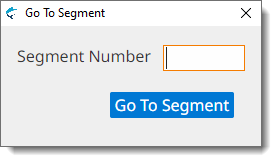
Go To Segment dialog
Press F9 or click the Check Inline Tags button () from the top toolbar and check the dialog that appears. Make sure that there are no tag erros in the project because the translated document may become unusable.
To verify that all initial and trailing spaces are OK, press F10 or click the Check Initial/Trailing Spaces button () on the top toolbar. This task in not required for some Asian target languages.
Step 4: Export translations
Once all segments have been translated and reviewed, generate the translated version of your project.
Click the Export Translations button () from the top toolbar or the Projects tab toolbar. The Operating System will display a dialog for selecting where to save the translated documents.
After your translations are exported, a new dialog will offer to open the translated file or folder.
Important Tips
- Browse the application menu to get a sense of all available options.
- Check Swordfish User Guide for additional information (press F1 at any time).
- Join Maxprograms Support Group group and ask for any assistance you may need.
